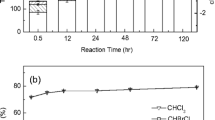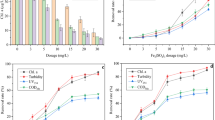Abstract
There is considerable interest in minimizing the chlorine residual in Japan because of increasing complaints about a chlorinous odor in drinking water. However, minimizing the chlorine residual causes the microbiological water quality to deteriorate, and stricter control of biodegradable organics in finished water is thus needed to maintain biological stability during water distribution. In this investigation, an acceptable level of assimilable organic carbon (AOC) for biologically stable water with minimized chlorine residual was determined based on the relationship between AOC, the chlorine residual, and bacterial regrowth. In order to prepare water samples containing lower AOC, the fractions of AOC and biodegradable organic matter (BOM) in tap water samples were reduced by converting into biomass after thermal hydrolysis of BOM at alkaline conditions. The batch-mode incubations at different conditions of AOC and chlorine residual were carried out at 20°C, and the presence or absence of bacterial regrowth was determined. The determined curve for biologically stable water indicated that the acceptable AOC was 10.9 μg C/L at a minimized chlorine residual (0.05 mg Cl2/L). This result indicated that AOC removal during current water treatment processes in Japan should be significantly enhanced prior to minimization of the chlorine residual in water distribution.





Similar content being viewed by others
References
American Public Health Association (APHA). (1998). Standard methods for the examination of water and wastewater (20th ed.). Washington, DC: APHA, American Water Works Association, and Water Pollution Control Federation.
Bruchet, A., & Duguet, J. P. (2004). Role of oxidants and disinfectants on the removal, masking and generation of tastes and odours. Water Science and Technology, 49(9), 297–306.
Escobar, I. C., & Randall, A. A. (2001). Assimilable organic carbon (AOC) and biodegradable dissolved organic carbon (BDOC): complementary measurements. Water Research, 35(18), 4444–4454.
Hammes, F., Berger, C., Köster, O., & Egli, T. (2010). Assessing biological stability of drinking water without disinfectant residuals in a full-scale water supply system. Journal of Water Supply Research and Technology-AQUA, 59, 31–40.
Itoh, S., Shiro, S., Hirayama, N., Echigo, S., & Ohkouchi, Y. (2007). Factors related to citizens’ satisfaction with tap water and analysis of improvement needs in water supply system. Environmental Sanitary Engineering Research, 21(1), 9–19 (in Japanese).
Japan Water Works Association (JWWA). (2001). Standard method for the examination of water. Tokyo: JWWA (in Japanese).
Japan Water Works Association (JWWA). (2010). Water supply statistics 2008. Tokyo: JWWA (in Japanese).
Jo, I. (2008). Contributions of hydrophilic or basic fractions of dissolved organic matter to haloacetic acid formation by a comprehensive fractionation technique. Master’s thesis, Graduate School of Engineering, Kyoto University (in Japanese).
Kumke, M. U., Specht, C. H., Brinkmann, T., & Frimmel, F. H. (2001). Alkaline hydrolysis of humic substances—spectroscopic and chromatographic investigations. Chemosphere, 45(6–7), 1023–1031.
Kyoto City Waterworks Bureau. (2008). Annual reports of water quality 2007. Kyoto: Kyoto City Waterworks Bureau (in Japanese).
Kyoto City Waterworks Bureau. (2009). Annual reports of water quality 2008. Kyoto: Kyoto City Waterworks Bureau (in Japanese).
LeChevallier, M. W. (2003). Conditions favouring coliform and HPC bacterial growth in drinking water and on water contact surfaces. In J. Bartram, J. Cotruvo, M. Exner, C. Fricker, & A. Glasmacher (Eds.), Heterotrophic plate counts and drinking-water safety, emerging issues in water and infectious diseases. London: WHO/IWA.
LeChevallier, M. W., Welch, N. J., & Smith, D. B. (1996). Full-scale studies of factors related to coliform regrowth in drinking water. Applied and Environmental Microbiology, 62(7), 2201–2211.
Manuel, C. M., Nunes, O. C., & Melo, L. F. (2007). Dynamics of drinking water biofilm in flow/non-flow conditions. Water Research, 41(3), 551–562.
Meylan, S., Hammes, F., Traber, J., Salhi, E., von Gunten, U., & Pronk, W. (2007). Permeability of low molecular weight organics through nanofiltration membranes. Water Research, 41, 3968–3976.
Murata, M., Echigo, S., & Itoh, S. (2010). Reducing effect of chlorinous odor by advanced oxidation and ion exchange treatment. Environmental Sanitary Engineering Research, 24(3), 27–30 (in Japanese).
Niquette, P., Servais, P., & Savoir, R. (2001). Bacterial dynamics in the drinking water distribution system of Brussels. Water Research, 35(3), 675–682.
Ohkouchi, Y., Ly, B. T., Ishikawa, S., Aoki, Y., Echigo, S., & Itoh, S. (2011). A survey on levels and seasonal changes of assimilable organic carbon (AOC) and its precursors in drinking water. Environmental Technology, 32(14), 1605–1613.
Park, S. K., & Hu, J. Y. (2010). Assessment of the extent of bacterial growth in reverse osmosis system for improving drinking water quality. Journal of Environmental Science and Health, Part A, 45(8), 968–977.
Pedersen, K. (1990). Biofilm development on stainless-steel and PVC surfaces in drinking-water. Water Research, 24(2), 239–243.
Servais, P., Laurent, P., & Randon, G. (1995). Comparison of the bacterial dynamics in various French distribution-systems. Journal of Water Supply Research and Technology-AQUA, 44(1), 10–17.
Sharp, R. R., Camper, A. K., Crippen, J. J., Schneider, O. D., & Leggiero, S. (2001). Evaluation of drinking water biostability using biofilm methods. Journal of Environmental Engineering, 127(5), 403–410.
Srinivasan, S., & Harrington, G. W. (2007). Biostability analysis for drinking water distribution systems. Water Research, 41(10), 2127–2138.
van der Kooij, D. (1992). Assimilable organic carbon as indicator of bacterial regrowth. Journal of American Water Works Association, 84, 57–65.
van der Kooij, D. (1998). Potential for biofilm development in drinking water distribution systems. Journal of Applied Microbiology, 85(Suppl 1), 39S–44S.
van der Kooij, D. (1999). Maintaining quality without disinfectant residual. Journal of American Water Works Association, 91(Jan), 55–64.
van der Kooij, D. (2000). Biological stability: a multidimensional quality aspect of treated water. Water, Air, and Soil Pollution, 123(1–4), 25–34.
van der Kooij, D., Visser, A., & Hijnen, W. A. M. (1982). Determining the concentration of easily assimilable organic carbon in drinking water. Journal of American Water Works Association, 74(Oct), 540–545.
van der Kooij, D., Veenendaal, H. R., Baarslorist, C., Vanderklift, D. W., & Drost, Y. C. (1995). Biofilm formation on surfaces of glass and Teflon exposed to treated water. Water Research, 29(7), 1655–1662.
van der Wielen, P. W. J. J., & van der Kooij, D. (2010). Effect of water composition, distance and season on the adenosine triphosphate concentration in unchlorinated drinking water in the Netherlands. Water Research, 44, 4860–4867.
Woolschlager, J. E., Rittmann, B. E., Piriou, P., Schwartz, B. (2002). Developing a simple factor to evaluate microbiological stability in distribution systems. In Proceedings of Annual Meeting of the American Water Works Association, Denver, Colorado.
Acknowledgments
This research was supported in part by a Grant-in-Aid for Scientific Research from the Ministry of Health, Labour and Welfare (H20-Health-006) and a Grant-in-Aid for Young Scientists (B) 21760460 from the Ministry of Education, Culture, Sports, Science and Technology.
Author information
Authors and Affiliations
Corresponding author
Rights and permissions
About this article
Cite this article
Ohkouchi, Y., Ly, B.T., Ishikawa, S. et al. Determination of an acceptable assimilable organic carbon (AOC) level for biological stability in water distribution systems with minimized chlorine residual. Environ Monit Assess 185, 1427–1436 (2013). https://doi.org/10.1007/s10661-012-2642-9
Received:
Accepted:
Published:
Issue Date:
DOI: https://doi.org/10.1007/s10661-012-2642-9




